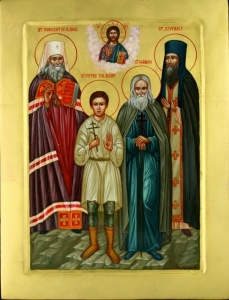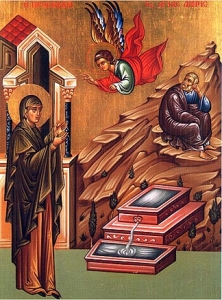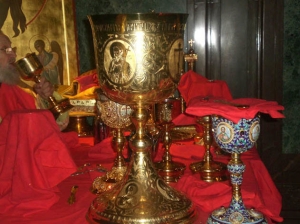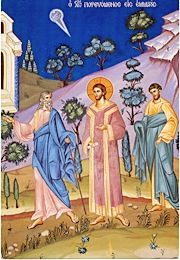Tag: The Church Year
Traveling to Bethlehem (12 December 2010)
All these icons look alike! How many time have we Orthodox heard this comment about icons. The reality is that there are subtle differences, often with great theological meaning. Today, is one of these times. The saint who we commemorate today is St Spyridon of Thymithous. Look closely, what is different about this icon? We see the familiar icon of a hierarch of the Church with his ecclesial vestments and carrying the Gospel book. Not much different from many icons we see in the Church. But, when we look closely we notice a strange hat on the figure. Most icons of the hierarchs are bare headed, what is the meaning of this strange triangular hat. By reading a bit, we discover that St. Spyridon had been a shepherd and was elected bishop because of his great piety. What did Spyridon do then? According to the Prologue of Ohrid, he continued to live simply and care for his livestock. He also shepherded his spiritual flock the people of his diocese. He was devoted to being a shepherd of souls. As we know, St. Spyridon was present at the first Ecumenical Council. A country bishop from a backwater diocese, really an unsophisticated, uneducated delegate. As his story tells us, the Holy Spirit enlightened Spyridon to expound the true theology of Christ, fully man and fully God. While he preached the truth, Arian one of the most erudite scholars in the Empire was put to shame. A shepherd and a bishop; perhaps our modern hierarchs can remember that they are at their hearts – simple shepherds. ]]>
Traveling to Bethlehem (08 December 2010)
Today is one of those days of preparation that the Church provides us to get ready for a holiday. Tomorrow, we commemorate the Conception of the Theotokos. Today, we get ready. We have an opportunity to pause and consider the importance of the coming event. Where should we look for a better understanding of the feast? Like many feasts of the Church this occurrence is not documented “in the Bible,” yet it is a significant happening in salvation history. Where does one go to learn about this festival? Where do you start? I decided to ask this question out loud; so that we could learn from each other. We know that the hymns of the Church describe the theology of a feast. What do they say? The Troparion sung at the Vespers for tomorrow speaks of the “bonds of barrenness being loosed” and of the “prayers” of Joachim and Anna asking for “birth beyond hope.” What do these clues tell us? If we read closely, we see that this couple was without children and beyond the hope of having children, they prayed for God to change their life. In an earlier post, we stated that many of our hymnographers got inspiration from the other writings, from the Christian Apocrypha. The book, the Protevagelium of James, (The Infancy Gospel of James) tells us the story of the birth of the Virgin Mary. We read in the first part of this book about the “prayer of St. Anna.” In her garden, Anna turns to God in her prayer. She describes her barren womb as contrasted to the fruitfulness of the natural creation. Anna begs Our Lord to bless her and allow to “bring forth fruit in her season.” An angel of the Lord appears to St. Anna and informs her that God has heard her prayer. He tells her that she would conceive and give birth to a child. In gratitude, Anna pledges to dedicate her child as a gift to God, since it would be a gift from God. Not only are these ancient sources inspiration for hymnographers; but also for iconographers (as we can see above). The child, which the angel announces is conceived as every child is, as a blessing from God; but this child is a blessing for all of humanity. ]]>
Traveling to Bethlehem (7 Dec. 2010)
Ours or Theirs? Grammatically, this might be an odd construct, but the question is valid. About now, you are probably asking yourself; what is he talking about? Have you ever wondered why we as Orthodox have difficulty accepting pre-schism western saints as ours? This is most common, I believe, it applies more when the saint in question is a famous or well known western saints. Today is a good example: St. Ambrose of Milan of St. Augustine. The more significant the contribution of a saint to the history of the western church the less we tend to recognize them. A few days ago, both Churches commemorated the memory of St. Cecelia. The question would then follow: “Is she one of ours?” I had the privilege of studying in England, in a small town called Durham. In the famous Durham Cathedral are entombed several Saints Cuthbert of Lindisfarne, Venerable Bede and King Oswald of North Umbria. My first reaction when I saw the tombs was to run to an Horologion to check if they were ”kosher.” This type of reaction is complicated by linguistic variations. How many know that St Photini, the Samaritan Woman, is called St Svetlana in Russia, St. Claire in France and St. Fiona in Celtic countries. Today the example of this possible confusion is St. Ambrose. St Ambrose fought Arianism being influenced by Athanasius, corresponded with St Basil and was a great influence on St. Augustine of Hippo. When we look at Saints think across the universal Church. Theirs are ours and ours are theirs and we are all enriched by this understanding.
]]>
Traveling to Bethlehem (28 November 2010)
Traveling to Bethlehem (26 November 2010)
** the next few posts are taken from a Homily given: Nov. 28, 2010 In the Name of the Father the Son and the Holy Spirit….. So they drew near to the village to which they were going. He appeared to be going further, but they constrained him, saying, “Stay with us, for it is toward evening and the day is now far spent.” So he went in to stay with them. When he was at table with them, he took the bread and blessed, and broke it, and gave it to them. And their eyes were opened and they recognised him; and he vanished out of their sight. They said to each other, “Did not our hearts burn within us while he talked to us on the road, while he opened to us the scriptures?” Luke 24, 28 – 32. This quote was taken from this morning’s Eothinon Gospel, the 5th. Dawn Gospel which was the reading in the Orthros (Matins) service. I thought to myself what an interesting coincidence that on the week of Thanksgiving, we should be hearing of Christ sitting down to eat with some of his disciples. We even read what was on the menu – bread. Our own tables last Thursday were so different, all of us had such abundance. No doubt, at most Thanksgiving Tables, there were the traditional foods: turkey, dressing, potatoes, cranberry and all types of pies. We in North America, the US and Canada, are the only countries which officially celebrate Thanksgiving. But, let’s look at our customs. Thanksgiving tables in our homes do have similarities. We gather as families or with a few close invited friends. The people we invite are like ourselves and they are carefully selected. Each Thanksgiving table is surrounded by the familiar: familiar foods and familiar people. This is the comfort of the holiday, the fact that we can be with the people close to us. But there is another Thanksgiving Table, one older than the table by which we remember the Pilgrims. It is the table, we gather around each time this family comes to give thanks. This table is open to all races, nationalities and peoples. It too is surrounded by a group of chosen friends, chosen by Christ to share in His bounty, His love and His life. Let’s examine the word’s St. John Chrysostomos uses to focus on the Gifts brought for God’s Holy Spirit bless and sanctify: “Thine Own of Thine Own in all and for all” This centres all of us on what? A piece of Bread? A Cup of Wine? Not these things, but the ultimate Thanksgiving, the body and blood of the lamb of God.]]>












